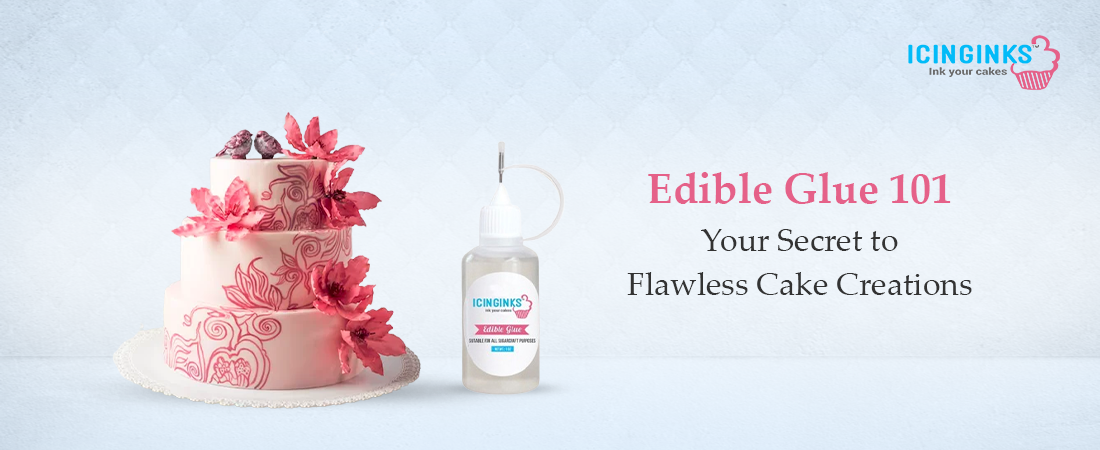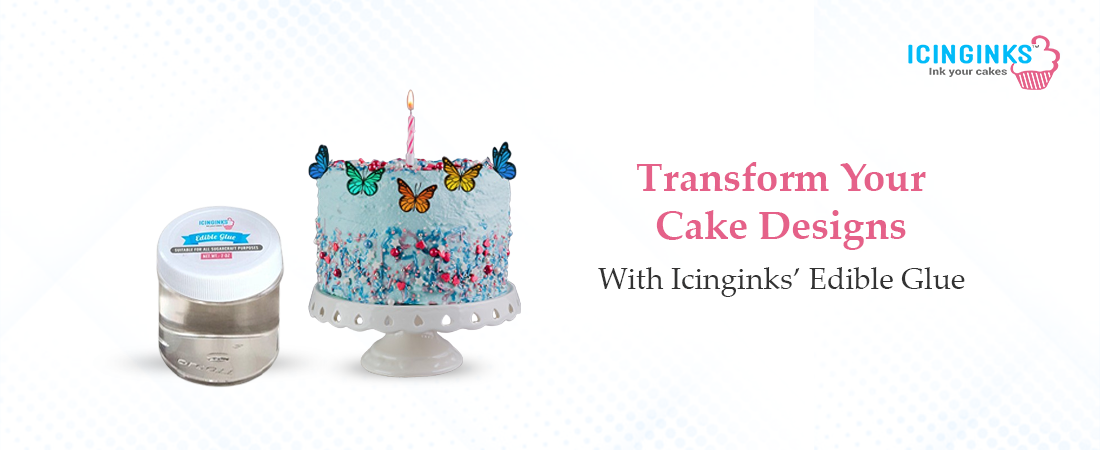
Ever wondered how bakers make delicate sugar flowers, edible toppers, and detailed fondant decorations stick together seamlessly? The answer is simple yet magical: edible glue! This unique, food-safe adhesive has become essential in baking and cake decorating, allowing bakers to craft intricate, show-stopping treats without worrying about pieces slipping off or falling apart. In this comprehensive guide, we’ll dive into the world of edible glue, its use, and why every baker should have it in their toolkit.
What is Edible Glue?
Edible glue is a special adhesive made entirely of food-grade ingredients, designed to hold various edible elements together in baking and cake decorating. Unlike regular glues, edible glue is safe to consume. It is the perfect solution for sticking decorations, such as sugar flowers, fondant pieces, and even lightweight decorations made with edible paper like icing sheets.
Typically, edible glue is a clear, syrupy liquid that dries almost invisibly, allowing bakers to work with intricate details without leaving visible residue. Most edible glues are made from ingredients like tylose powder or gum arabic, which provide a strong but flexible hold that is ideal for delicate edible elements.
Why Do Bakers Use Edible Glue?
For bakers, edible glue is an invaluable tool. Whether you're a professional cake artist or a home baker, edible glue can help bring your ideas to life. Here are some common uses:
1. Attaching Fondant and Gum Paste
Edible glue frequently attaches fondant or gum paste decorations to cakes. It provides a reliable bond without damaging the decorations.
2. Layering Icing Sheets
For bakers who use edible printers to print custom designs on icing sheets, edible glue is ideal for attaching those sheets to cookies, cakes, or other baked goods.
3. Assembling Edible Structures
From 3D cake toppers to gingerbread houses, edible glue helps assemble intricate structures that hold together even under weight.
4. Securing Small Details
In fine detailing work, edible glue is perfect for securing tiny accents like pearls, dragees, and other small edible decorations without the risk of them falling off.
Using edible glue, bakers can achieve precise decoration work while ensuring everything remains firmly in place – from baking to final presentation.
Types of Edible Glue
Various types of edible glue are available, each suited to different purposes. Here are some of the most common options:
1. Tylose Powder-Based Glue
Tylose powder is a popular ingredient in cake decorating. Mixing a small amount of tylose powder with water creates a thick, sticky, edible glue ideal for securing heavier decorations, such as fondant and gum paste figures.
2. Gum Arabic Glue
Gum arabic, a natural gum from the acacia tree, can make edible glue. It creates a thinner consistency, making it suitable for delicate decorations like icing sheets and thin edible paper. This type of glue dries clear and provides a strong hold.
3. Corn Syrup Glue
Corn syrup is a simple option that provides a quick fix for lightweight decorations. It’s sticky enough to hold edible decorations like sprinkles or glitter but may not be strong enough for larger fondant pieces.
4. Ready-Made Edible Glue
For convenience, ready-made edible glue is available in most baking supply stores. It comes in a pre-mixed solution, ideal for those who want a quick and easy solution. This option saves time and ensures consistency in texture and strength.
How to Use Edible Glue: Tips and Techniques
Using edible glue correctly is crucial for achieving the best results. Here are some helpful tips to make the most of this essential baking tool:
1. Use a Small Brush
To apply edible glue precisely, use a small food-safe brush. This technique is particularly useful for attaching delicate details without over-saturating the decorations.
2. Apply Sparingly
Edible glue is very effective even in small amounts, so a little goes a long way. Applying too much can make the decorations soggy or slippery.
3. Allow Time to Dry
After applying edible glue, dry it and set it for a few minutes. This will ensure a strong bond, especially when working with heavy or multi-layered decorations.
4. Experiment with Consistencies
Different projects may require different glue consistencies. For instance, a thicker edible glue is best for attaching fondant pieces, while a thinner version works better for lightweight items like icing sheets.
With these tips, using edible glue can become a seamless part of your decorating process, helping you achieve professional results.
How to Make Edible Glue at Home
For bakers who prefer a DIY approach, edible glue can be made easily at home. Here’s a simple recipe for creating your edible glue:
Ingredients:
- 1/4 teaspoon Tylose powder (or CMC powder)
- 1 tablespoon water
Instructions:
- Mix the tylose powder with water in a small container.
- Stir until the mixture starts to thicken. You may notice it turning clear as it dissolves.
- Let it sit for 10-15 minutes to achieve the desired consistency.
Once prepared, this homemade edible glue can be stored in an airtight container in the refrigerator for up to a week. Always stir it before each use, as the ingredients may separate over time.
Troubleshooting Common Issues with Edible Glue
While edible glue is fairly straightforward, there can be a few challenges. Here are some common issues and how to solve them:
1. Glue Too Thick or Lumpy
If your edible glue is too thick, add a small amount of water to thin it out. Stir well to remove lumps.
2. Weak Adhesion
If the glue isn’t holding well, ensure the surfaces you work with are clean and free from dust or grease.
3. Over-Saturation
Over-applying edible glue can make decorations slippery. Use a small amount to prevent this issue and avoid damaging delicate elements.
Knowing how to troubleshoot these problems can make edible glue easier, leading to more polished results.
Edible Glue – An Essential Tool for Creative Bakers
From attaching fondant to layering icing sheets, edible glue is a must-have for any baker aiming for a professional finish. This versatile, food-safe adhesive opens up a world of decorating possibilities, allowing bakers to achieve intricate designs, stable structures, and stunning effects that captivate and impress. Whether crafting custom cakes or designing detailed cookies, edible glue provides the perfect solution for holding everything together in the sweetest way possible.
So, next time you're in the kitchen, remember to keep your edible glue close – because with it, you can make any baking project stick!
Sweeten Your Cake Creations with Icinginks!

At Icinginks, we understand that every detail matters in cake decorating. We offer high-quality icing sheets and edible glue to help you easily create stunning, professional designs. Our edible printer technology ensures vibrant, full-color images that make your cakes and treats stand out.
Whether you're a hobbyist or a professional baker, our products are designed to inspire your creativity. With Icinginks, you can confidently bring your ideas to life, ensuring your decorations look fantastic and stay perfectly in place. Discover the joy of baking with us today!
FAQs
1. What is edible glue, and how is it used in baking?
Edible glue is a food-safe adhesive used in baking to bond edible decorations, like fondant or icing sheets, to cakes and treats. It enhances stability and ensures designs stay in place. It's ideal for intricate decorations, helping bakers easily achieve professional-looking results.
2. What are the different types of edible glue?
Common types of edible glue include water-based adhesive, royal icing, and commercial cake glues. Water-based glue is versatile, while royal icing hardens when dry, making it great for detailed decorations. Commercial options often come in bottles for easy application, providing convenience for hobbyists and professionals.
3. How do I apply edible glue effectively?
To apply edible glue effectively, use a small brush or a piping bag for precise application. Ensure the surfaces to be glued are clean and dry. Apply a thin layer of glue to one surface, press them together gently, and allow it to dry completely for best results.
4. Can I make homemade edible glue?
Yes, homemade edible glue can be made using simple ingredients. A popular recipe includes mixing 1 part water with 1 part corn syrup or using a paste made from powdered sugar and water. This provides a cost-effective alternative for bakers looking to create their adhesive.
5. Is edible glue safe for all types of cake decorations?
Edible glue is safe for most cake decorations, including fondant, gum paste, and icing sheets. However, always check product labels to ensure compatibility, especially with non-food items. For best results, use edible glues designed specifically for food applications to avoid any issues with safety or taste.
More interesting blogs to read on Icinginks
Edible Printing on a Budget: Cost-Effective Tips and Tricks
Custom Printed Edible Images for Corporate Events and Brand Promotions
Edible Cake Toppers vs. Traditional Cake Decorations: Which is Better?
How to Make Edible Printed Cookies at Home: A Beginner's Guide
Edible Pens vs. Markers: When to Use Each




